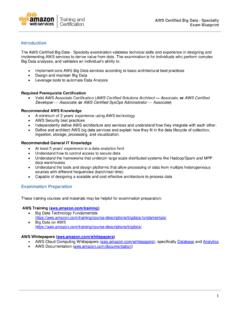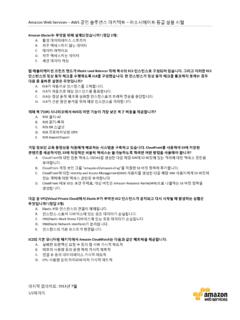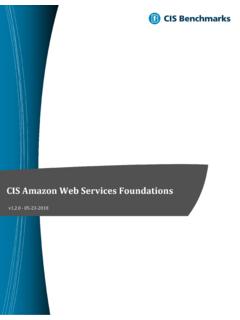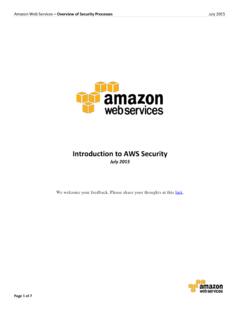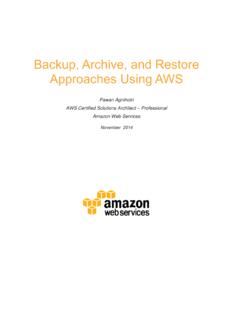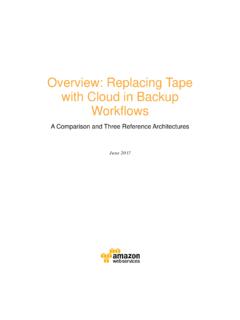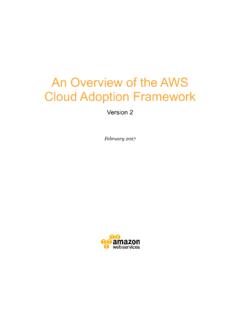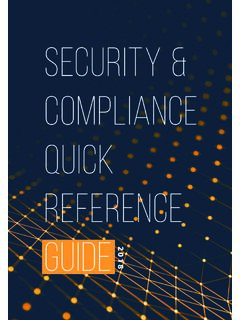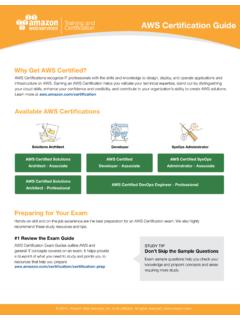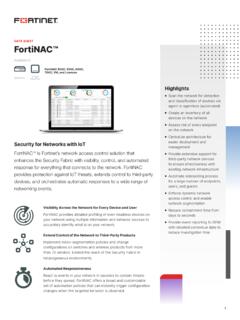Transcription of Amazon Web Services: Risk and Compliance
1 Amazon Web Services: Risk and Compliance May 2017. We welcome your feedback. Please share your thoughts at this link. Amazon Web Services Risk and Compliance May 2017. This document is intended to provide information to assist AWS customers with integrating AWS into their existing control framework supporting their IT environment. This document includes a basic approach to evaluating AWS controls and provides information to assist customers with integrating control environments. This document also addresses AWS-specific information around general cloud computing Compliance questions. Table of Contents Risk and Compliance Overview.
2 3. Shared Responsibility Environment .. 3. Strong Compliance Governance .. 4. Evaluating and Integrating AWS Controls ..4. AWS IT Control Information .. 5. AWS Global Regions .. 5. AWS Risk and Compliance Program ..6. Risk management .. 6. Control Environment .. 6. Information Security .. 7. AWS Certifications, Programs, Reports, and Third-Party CJIS .. 7. CSA .. 7. Cyber Essentials Plus .. 8. DoD SRG Levels 2 and 4 .. 8. FedRAMP SM .. 8. FERPA .. 9. FIPS 140-2 .. 9. FISMA and DIACAP .. 9. GxP .. 9. HIPAA .. 10. IRAP .. 10. ISO 9001 .. 10. ISO 27001 .. 11. ISO 11. ISO 27018 .. 12. ITAR .. 12. MPAA .. 12. MTCS Tier 3 Certification.
3 13. Page 2 of 81. Amazon Web Services Risk and Compliance May 2017. NIST .. 13. PCI DSS Level 13. SOC 1/ISAE 3402 .. 14. SOC 2 .. 15. SOC 3 .. 15. Key Compliance Questions and 15. AWS Contact ..20. Appendix A: CSA Consensus Assessments Initiative Questionnaire ..21. Appendix B: AWS alignment with the Australian Signals Directorate (ASD) Cloud Computing Security Considerations ..57. Appendix C: Glossary of Terms ..77. Risk and Compliance Overview AWS and its customers share control over the IT environment, both parties have responsibility for managing the IT environment. AWS' part in this shared responsibility includes providing its services on a highly secure and controlled platform and providing a wide array of security features customers can use.
4 The customers'. responsibility includes configuring their IT environments in a secure and controlled manner for their purposes. While customers don't communicate their use and configurations to AWS, AWS does communicate its security and control environment relevant to customers. AWS does this by doing the following: Obtaining industry certifications and independent third-party attestations described in this document Publishing information about the AWS security and control practices in whitepapers and web site content Providing certificates, reports, and other documentation directly to AWS customers under NDA (as required). For a more detailed description of AWS security please see: AWS Security Center: For a more detailed description of AWS Compliance please see AWS Compliance page: Additionally, The AWS Overview of Security Processes Whitepaper covers AWS' general security controls and service-specific security.
5 Shared Responsibility Environment Moving IT infrastructure to AWS services creates a model of shared responsibility between the customer and AWS. This shared model can help relieve customer's operational burden as AWS operates, manages and controls the components from the host operating system and virtualization layer down to the physical security of the facilities in which the service operates. The customer assumes responsibility and management of the guest operating system (including updates and security patches), other associated application software as well as the configuration of the AWS provided security group firewall. Customers should carefully consider the services they choose as their responsibilities vary depending on the services used, the integration of those Page 3 of 81.
6 Amazon Web Services Risk and Compliance May 2017. services into their IT environment, and applicable laws and regulations. It is possible for customers to enhance security and/or meet their more stringent Compliance requirements by leveraging technology such as host based firewalls, host based intrusion detection/prevention, encryption and key management . The nature of this shared responsibility also provides the flexibility and customer control that permits the deployment of solutions that meet industry-specific certification requirements. This customer/AWS shared responsibility model also extends to IT controls. Just as the responsibility to operate the IT environment is shared between AWS and its customers, so is the management , operation and verification of IT controls shared.
7 AWS can help relieve customer burden of operating controls by managing those controls associated with the physical infrastructure deployed in the AWS environment that may previously have been managed by the customer. As every customer is deployed differently in AWS, customers can take advantage of shifting management of certain IT controls to AWS which results in a (new) distributed control environment. Customers can then use the AWS control and Compliance documentation available to them (described in the AWS Certifications and Third-party Attestations section of this document) to perform their control evaluation and verification procedures as required.
8 The next section provides an approach on how AWS customers can evaluate and validate their distributed control environment effectively. Strong Compliance Governance As always, AWS customers are required to continue to maintain adequate governance over the entire IT control environment regardless of how IT is deployed. Leading practices include an understanding of required Compliance objectives and requirements (from relevant sources), establishment of a control environment that meets those objectives and requirements, an understanding of the validation required based on the organization's risk tolerance, and verification of the operating effectiveness of their control environment.
9 Deployment in the AWS cloud gives enterprises different options to apply various types of controls and various verification methods. Strong customer Compliance and governance might include the following basic approach: 1. Review information available from AWS together with other information to understand as much of the entire IT environment as possible, and then document all Compliance requirements. 2. Design and implement control objectives to meet the enterprise Compliance requirements. 3. Identify and document controls owned by outside parties. 4. Verify that all control objectives are met and all key controls are designed and operating effectively.
10 Approaching Compliance governance in this manner will help companies gain a better understanding of their control environment and will help clearly delineate the verification activities to be performed. Evaluating and Integrating AWS Controls AWS provides a wide range of information regarding its IT control environment to customers through white papers, reports, certifications, and other third-party attestations. This documentation assists customers in understanding the controls in place relevant to the AWS services they use and how those controls have been validated. This information also assists customers in their efforts to account for and to validate that controls in their extended IT environment are operating effectively.

